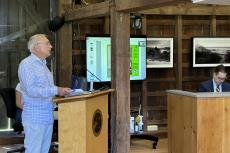The East Hampton Town Board is considering numerous revisions to the town code pegged to accessory dwellings. At the board’s Tuesday work session, members heard from Jeremy Samuelson, the town planning director, and the assistant planning director, Eric Schantz, who presented a range of options so the town might tackle a chronic and growing shortage of affordable housing units.
“We have lost a huge amount of housing rental stock in the past five years,” Supervisor Peter Van Scoyoc said, to investment properties, conversions of home rentals for seasonal use only, ever-increasing home values, and the pandemic.
“There is an opportunity to solve this problem by using existing property,” he said. “We are not going to build our way out of this problem,” he added, stressing that using existing property “requires removing some of the barriers” and possibly lifting the cap on the number of permissible buildouts of detached accessory units in the town.
Tuesday’s session focused on those accessory affordable housing units now covered under 2016 affordable housing legislation, which allowed for the construction of up to 20 detached housing units in each of the town’s five areas as defined by school district, from Montauk to Wainscott, for a potential total of 100 new units of affordable housing.
To date, 47 have been built. Only East Hampton has maxed out its 20 units.
Now the town is discussing raising that limit to 40, despite the fact that, for example, Montauk built six detached affordable housing units in six years and Wainscott constructed one — but the town yanked that home from its affordable housing program umbrella after its owner was caught renting it to vacationers via Airbnb.
The board discussed what factors may be keeping people from wanting to participate in the affordable housing program, and how to encourage homeowners who would otherwise be interested in building accessory housing units if they were for family members.
The 2016 legislation also restricted where detached accessory units can be constructed and restricted any from being built in protected harbor areas or, ironically enough, in areas that are already carved out as affordable housing overlay districts.
Mr. Samuelson explained that as far as the harbor protection overlay districts go, those restrictions were put in place to minimize pollution in drinking and surface water, but he noted that in subsequent years the board has voted to require on-site sewage treatment infrastructure for new buildings or if an existing building is altered from four to five bedrooms.
“We now have better code and better technology,” Mr. Samuelson said in his comments to board members as he recommended that they consider opening those areas for possible detached housing units.
Mr. Van Scoyoc could only wonder aloud why the town wouldn’t allow affordable housing to be constructed in areas designated as affordable housing districts.
The board is also considering increasing the number of allowable bedrooms in detached accessory units from one to two. This would allow, for example, a young family who would like to settle in town to have sufficient space to raise a family. The idea would be to provide not just entry-level housing “but also in multiple stages through their life, so they can stay in the community,” Mr. Samuelson said.
The town is struggling with losing younger people who can’t afford to live here and a shrinking middle class that’s getting squeezed by high rents and the high cost of living. Without any tangible opportunity to attain affordable housing, that crunch on the middle class “puts the hit on us,” Mr. Van Scoyoc said, highlighting the critical “middle-income band that’s driving our economy and providing professional resources to our community.”
The 2016 legislation delineated two categories of accessory units — detached apartments and those that are a part of the primary residence. The detached units were restricted to 600 square feet — “somewhat onerous,” Mr. Samuelson observed as he suggested that the town may want to increase the allowable square footage to 900 square feet, which is the limit set for attached accessory units.
Mr. Samuelson cautioned, however, that he has received lots of community comment on that issue, about two-thirds of it opposed. On a less contentious note, Mr. Samuelson said the town might consider decreasing the minimum lot size required to build a detached unit from 30,000 to 20,000 square feet, which would align town policy for attached and detached dwellings.
Mr. Schantz described this as “the most impactful” change the board might consider, as it might affect homeowners now locked out of the program. He noted that in Amagansett, for example, 42 percent of properties of least 30,000 square feet could participate in the town’s affordable housing initiative. If that square footage were reduced to 20,000, the number of qualifying homes would jump to 59 percent.
“It does increase the availability of what lots could apply for this,” Mr. Schantz said. The detached accessory unit program is popular in two school districts, Springs and East Hampton, but not in the other three. “By doing this you’d increase the reach and availability.”
The board is also considering changes to who may occupy affordable units and when. One reform to the current code would allow a homeowner to live in the accessory dwelling and rent the primary residence. “We don’t see the harm in that,” Mr. Van Scoyoc said.
Those homeowners may have outgrown their homes — the kids moved out, the bedrooms are all empty — and might be looking for some flexibility in how they could make use of their affordable housing unit.
Also being considered is the elimination of a year-round occupancy requirement for tenants baked into the 2016 legislation, as doing so would formally accommodate a seasonal-housing dynamic unique to the town. The board generally agreed that it would be a good idea. Prospective tenants would then have to show only that they work here to qualify.
The main impediment to easing the affordable housing crunch in town, Mr. Samuelson said, came back to the issue of incentivizing homeowners, most of whom aren’t going to borrow money to build an accessory dwelling for a stranger, but would if it’s a family member in need of housing. “Most people won’t do this out of a sense of largess to the community,” he said.
The town’s affordable housing program is structured so that the maximum rent that can be charged is 110 percent of the fair market rent, which is based on census tracking. The problem, said Mr. Samuelson, is that fair market rents are not the same in East Hampton as they are in East Meadow.
“This is a really rough hand for us to work with as we try to solve these problems,” he said, suggesting that the town might consider allowing owners to charge up to 130 percent of fair market rents.
People who move into these apartments would be paying more rent, he conceded, but he stressed that raising the rent cap might provide a reason for a homeowner to build a detached accessory unit.
The upshot from Tuesday’s meeting was that the town’s housing crunch has entered a new and critical phase, and something has to give. Mr. Samuelson said he was driving around Northwest Woods recently and had an anti-eureka moment of sorts when he contemplated “the travesty of unoccupied houses versus the crushing need we have for housing for people.”




